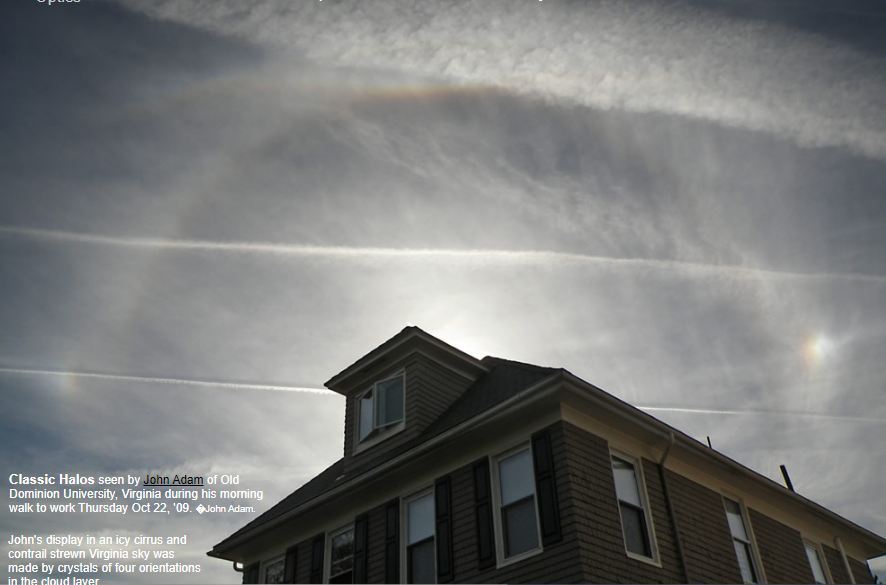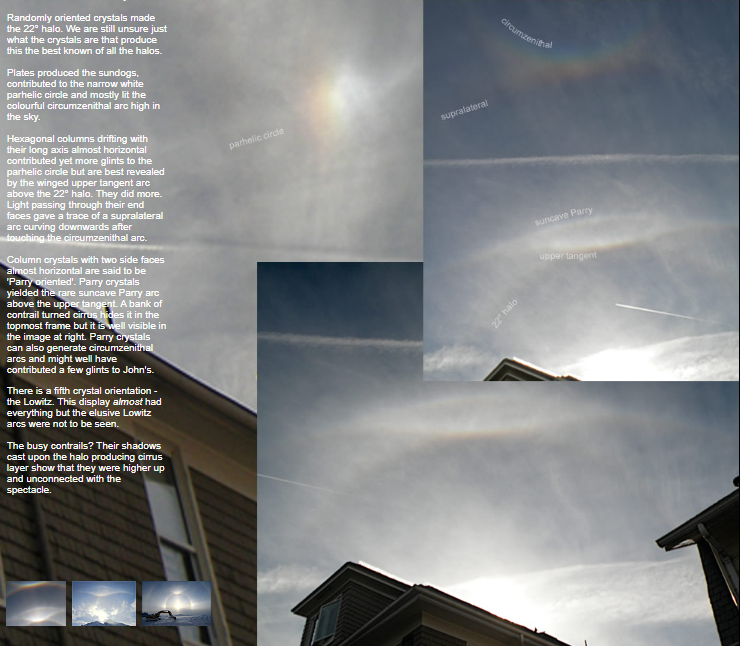Virginian Halos
Virginian Halos: A Spectacular Display of Atmospheric Optics
Have you ever witnessed a mesmerizing display of halos in the sky? If you happen to be in Virginia on a fortunate day, you might just experience the breathtaking phenomenon known as "Virginian Halos." These captivating optical phenomena occur when light interacts with ice crystals in the atmosphere, creating a spectacle that leaves onlookers in awe.
The display captured by John Adam of Old Dominion University on October 22, 2009, serves as a perfect example of Virginian Halos. Let's delve deeper into the various elements that contribute to this enchanting atmospheric phenomenon.
The 22° Halo: A Mystery Crystal Formation
One of the most prominent features of Virginian Halos is the 22° halo. This halo appears as a ring around the Sun or Moon, approximately 22 degrees away from the celestial body. While we are still uncertain about the exact nature of the crystals responsible for this halo, they are believed to be randomly oriented. These crystals scatter and refract light, giving rise to the well-known 22° halo.
Sundogs: An Icy Delight
Another fascinating element of Virginian Halos is the presence of sundogs. These are bright spots that appear on either side of the Sun and are caused by plate-shaped ice crystals. These crystals align horizontally in the atmosphere, creating a beautiful mirage-like effect. Sundogs contribute not only to the narrow white parhelic circle but also illuminate the colorful circumzenithal arc high up in the sky.
Hexagonal Columns and their Contributions
Hexagonal columns play a crucial role in enhancing the spectacle of Virginian Halos. These ice crystals have their long axis almost parallel to the ground as they drift through the atmosphere. As light interacts with these crystals, they produce additional glints in the parhelic circle. The winged upper tangent arc, located above the 22° halo, is the best indicator of these hexagonal columns. Furthermore, when light passes through the end faces of these crystals, it creates a trace of a supralateral arc, curving downwards after touching the circumzenithal arc.
Parry Crystals: A Rare Sight
Within the display of Virginian Halos, we can also observe Parry crystals. These column crystals have two side faces that are almost parallel to the ground, a configuration known as "Parry oriented." Parry crystals are responsible for generating the rare suncave Parry arc, which appears above the upper tangent. Although this particular arc is often concealed by cirrus clouds or contrails, it can occasionally be seen. Parry crystals can also contribute to the formation of circumzenithal arcs and add a few glints to the overall display.
The Elusive Lowitz Arcs
While the Virginian Halos witnessed by John Adam had an impressive array of crystal formations, one particular element was missing—the Lowitz arcs. These arcs, named after Johann Georg Lowitz who first described them in 1790, are elusive and not commonly observed. They form when light interacts with specific ice crystal orientations. Unfortunately, on this occasion, the Lowitz arcs remained unseen.
Contrails and their Role
Amidst the enchanting display of Virginian Halos, one may notice the presence of contrails—artificial clouds formed by aircraft exhaust. These contrails cast shadows on the halo-producing cirrus layer, indicating that they were higher up in the atmosphere and unrelated to the spectacle. While they add to the visual complexity, they do not directly contribute to the formation of the halos.
Virginian Halos are a testament to the wonders of atmospheric optics. The intricate interplay between ice crystals and light creates a stunning visual feast for those lucky enough to witness it. So, keep your eyes on the sky during frosty Virginia mornings, and you might just be treated to a celestial display that will leave you in awe.

Classic Halos seen by John Adam of Old Dominion University, Virginia during his morning walk to work Thursday Oct 22, '09. �John Adam.
John's display in an icy cirrus and contrail strewn Virginia sky was made by crystals of four orientations in the cloud layer.
Randomly oriented crystals made the 22° halo. We are still unsure just what the crystals are that produce this the best known of all the halos.
Plates produced the sundogs, contributed to the narrow white parhelic circle and mostly lit the colourful circumzenithal arc high in the sky.
Hexagonal columns drifting with their long axis almost horizontal contributed yet more glints to the parhelic circle but are best revealed by the winged upper tangent arc above the 22° halo. They did more. Light passing through their end faces gave a trace of a supralateral arc curving downwards after touching the circumzenithal arc.
Column crystals with two side faces almost horizontal are said to be 'Parry oriented'. Parry crystals yielded the rare suncave Parry arc above the upper tangent. A bank of contrail turned cirrus hides it in the topmost frame but it is well visible in the image at right. Parry crystals can also generate circumzenithal arcs and might well have contributed a few glints to John's.
There is a fifth crystal orientation - the Lowitz. This display almost had everything but the elusive Lowitz arcs were not to be seen.
The busy contrails? Their shadows cast upon the halo producing cirrus layer show that they were higher up and unconnected with the spectacle.

Note: this article has been automatically converted from the old site and may not appear as intended. You can find the original article here.
Reference Atmospheric Optics
If you use any of the definitions, information, or data presented on Atmospheric Optics, please copy the link or reference below to properly credit us as the reference source. Thank you!
-
<a href="https://atoptics.co.uk/blog/virginian-halos/">Virginian Halos</a>
-
"Virginian Halos". Atmospheric Optics. Accessed on April 24, 2024. https://atoptics.co.uk/blog/virginian-halos/.
-
"Virginian Halos". Atmospheric Optics, https://atoptics.co.uk/blog/virginian-halos/. Accessed 24 April, 2024
-
Virginian Halos. Atmospheric Optics. Retrieved from https://atoptics.co.uk/blog/virginian-halos/.